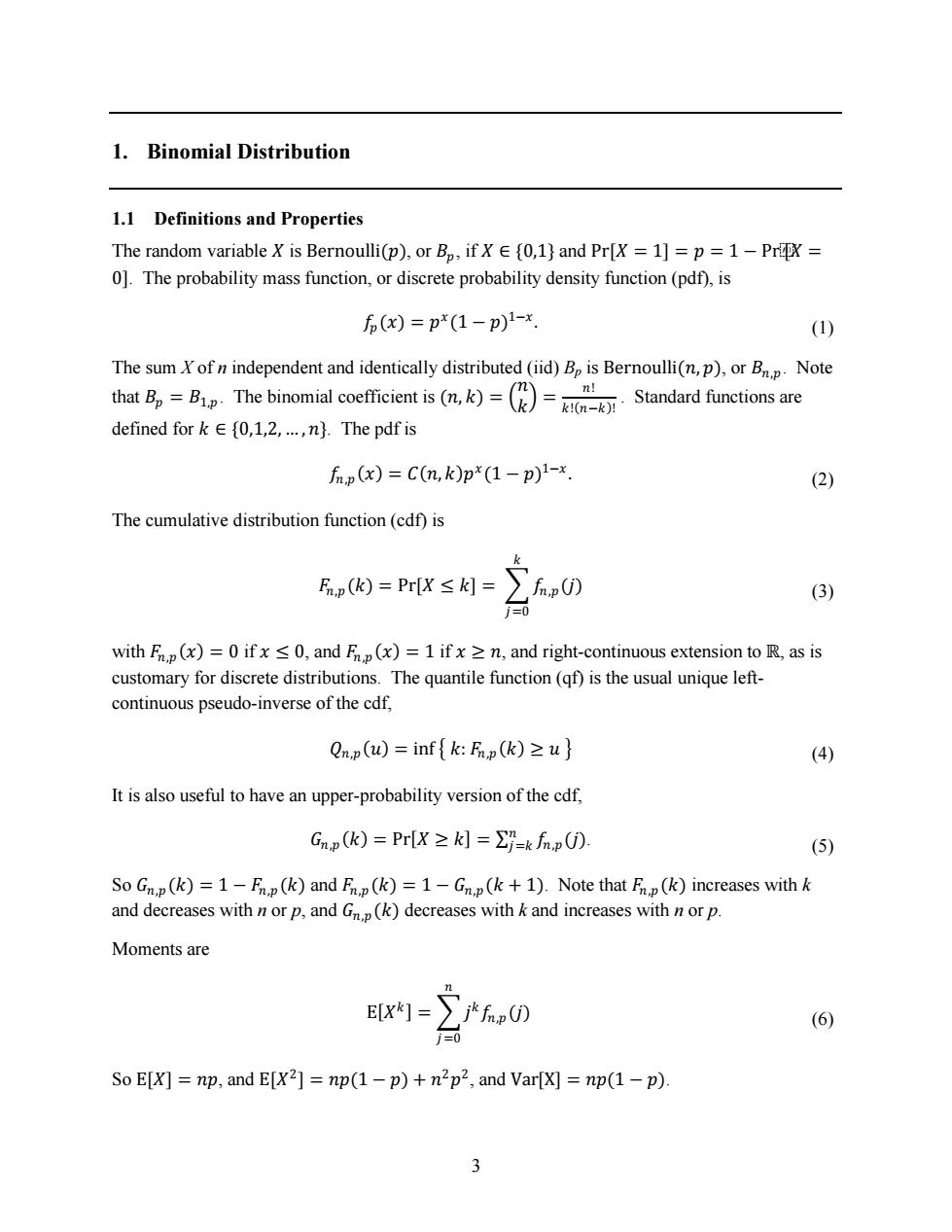正在加载图片...

1.Binomial Distribution 1.1 Definitions and Properties The random variable X is Bernoulli(p),or Bp,if X E{0,1}and Pr[X =1]=p=1-Pr 0].The probability mass function,or discrete probability density function(pdf),is f万(x)=p*(1-p)1-x. (1) The sum Xofn independent and identically distributed(iid)Bp is Bernoulli(n,p),or Bp.Note that The binomial coeficient is ( Standard functions are defined for k∈{0,l,2,.,n}.The pdf is fp(x)=C(n,k)p*(1-p)1-x. (2) The cumulative distribution function(cdf)is Enp(k)=Pr[X≤k= (3) with Fp(x)=0 ifx<0,and Fp(x)=1 if x>n,and right-continuous extension to R,as is customary for discrete distributions.The quantile function(qf)is the usual unique left- continuous pseudo-inverse of the cdf, Qnp(u)=inf {k:Fip(k)u} (4) It is also useful to have an upper-probability version of the cdf, Gnp (k)=Pr[X z k]=Ef=k fp ( (5) So Gnp(k)=1-Fp(k)and Fp(k)=1-Gnp(k +1).Note that Fp(k)increases with k and decreases with norp,and Gnp(k)decreases with k and increases with n or p. Moments are Ex的]=∑*后p0 (6) i=0 So E[X]np,and E[X2]np(1-p)+n2p2,and Var[x]np(1-p). 33 1. Binomial Distribution 1.1 Definitions and Properties The random variable 𝑋𝑋 is Bernoulli(𝑝𝑝), or 𝐵𝐵𝑝𝑝, if 𝑋𝑋 ∈ {0,1} and Pr[𝑋𝑋 = 1] = 𝑝𝑝 = 1 − Pr[𝑋𝑋 = 0]. The probability mass function, or discrete probability density function (pdf), is 𝑓𝑓𝑝𝑝 (𝑥𝑥) = 𝑝𝑝𝑥𝑥 (1 − 𝑝𝑝)1−𝑥𝑥. (1) The sum X of n independent and identically distributed (iid) Bp is Bernoulli(𝑛𝑛, 𝑝𝑝), or 𝐵𝐵𝑛𝑛,𝑝𝑝. Note that 𝐵𝐵𝑝𝑝 = 𝐵𝐵1,𝑝𝑝. The binomial coefficient is (𝑛𝑛, 𝑘𝑘) = � 𝑛𝑛 𝑘𝑘� = 𝑛𝑛! 𝑘𝑘!(𝑛𝑛−𝑘𝑘)! . Standard functions are defined for 𝑘𝑘 ∈ {0,1,2, … , 𝑛𝑛}. The pdf is 𝑓𝑓𝑛𝑛,𝑝𝑝 (𝑥𝑥) = 𝐶𝐶(𝑛𝑛, 𝑘𝑘)𝑝𝑝𝑥𝑥 (1 − 𝑝𝑝)1−𝑥𝑥 . (2) The cumulative distribution function (cdf) is 𝐹𝐹𝑛𝑛,𝑝𝑝 (𝑘𝑘) = Pr[𝑋𝑋 ≤ 𝑘𝑘] = �𝑓𝑓𝑛𝑛,𝑝𝑝 (𝑗𝑗) 𝑘𝑘 𝑗𝑗=0 (3) with 𝐹𝐹𝑛𝑛,𝑝𝑝 (𝑥𝑥) = 0 if 𝑥𝑥 ≤ 0, and 𝐹𝐹𝑛𝑛,𝑝𝑝 (𝑥𝑥) = 1 if 𝑥𝑥 ≥ 𝑛𝑛, and right-continuous extension to ℝ, as is customary for discrete distributions. The quantile function (qf) is the usual unique leftcontinuous pseudo-inverse of the cdf, 𝑄𝑄𝑛𝑛,𝑝𝑝 (𝑢𝑢) = inf � 𝑘𝑘: 𝐹𝐹𝑛𝑛,𝑝𝑝 (𝑘𝑘) ≥ 𝑢𝑢 � (4) It is also useful to have an upper-probability version of the cdf, 𝐺𝐺𝑛𝑛,𝑝𝑝 (𝑘𝑘) = Pr[𝑋𝑋 ≥ 𝑘𝑘] = ∑ 𝑓𝑓𝑛𝑛,𝑝𝑝 (𝑗𝑗) 𝑛𝑛 𝑗𝑗=𝑘𝑘 . (5) So 𝐺𝐺𝑛𝑛,𝑝𝑝 (𝑘𝑘) = 1 − 𝐹𝐹𝑛𝑛,𝑝𝑝 (𝑘𝑘) and 𝐹𝐹𝑛𝑛,𝑝𝑝 (𝑘𝑘) = 1 − 𝐺𝐺𝑛𝑛,𝑝𝑝 (𝑘𝑘 + 1). Note that 𝐹𝐹𝑛𝑛,𝑝𝑝 (𝑘𝑘) increases with k and decreases with n or p, and 𝐺𝐺𝑛𝑛,𝑝𝑝 (𝑘𝑘) decreases with k and increases with n or p. Moments are E[𝑋𝑋𝑘𝑘 ] = �𝑗𝑗𝑘𝑘 𝑓𝑓𝑛𝑛,𝑝𝑝 (𝑗𝑗) 𝑛𝑛 𝑗𝑗=0 (6) So E[𝑋𝑋] = 𝑛𝑛𝑛𝑛, and E[𝑋𝑋2] = 𝑛𝑛𝑛𝑛(1 − 𝑝𝑝) + 𝑛𝑛2𝑝𝑝2, and Var[X] = 𝑛𝑛𝑛𝑛(1 − 𝑝𝑝)